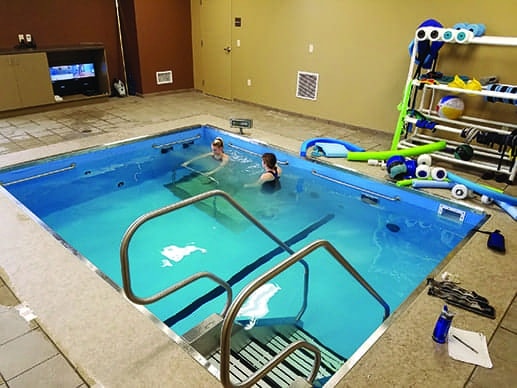
Patients recovering muscle memory or returning to running after an ankle or ACL injury may be apprehensive about being in the pool. Yet when they learn about the role underwater cameras can play in their recovery, they gain confidence and buy-in for the process.
by Rebecca Burke, PT, DPT, GCS
When Rock Valley dove into aquatic therapy about a decade ago, the local YMCA graciously accommodated us with limited private pool time throughout the week. Unfortunately, it was not flexible enough to accommodate the growing need to treat all patient populations. The solution to this challenge? Investing in an on-site pool, thereby freeing the practice’s ability to serve the public in innovative, exciting ways. All that was needed was a catalyst to move to the next level, which was received in the form of a well-respected regional orthopedic provider.
Building a Platform of Believers
Rock Valley PT has had a wonderful relationship for years with ORA Orthopedics, a thriving entity in our hometown. When ORA decided to build a new facility complete with pool, our team jumped at the opportunity. For a long time, we had built an ecosystem of employees and clients who embraced the power of water for therapy purposes. At the same time, ORA realized the benefits of water, as well as our expertise in delivering high-quality hydrotherapy.
Ours has been a symbiotic relationship from the get-go, and the desire to team up simply made sense. Consequently, we began to investigate which type of advanced therapy pool was best suited for our needs.
Having spent many years involved in the aquatics market, I took the lead in the investigation to uncover possible pools, exploring available units and testing them rigorously. Not only did I gain a deeper understanding of the myriad of options on the market, but I had the chance to feel what patients would experience in the water. Ultimately, we chose a product with several key features, including an underwater treadmill, variable depth levels, real-time video feedback, and stability bars.
Was it a leap of faith? Not really. We weren’t going in cold. Yet we had no idea what to exactly expect. Would it take off immediately? Would the pool sit empty for long periods? We wouldn’t know until the first patients entered.
By March 2017, the pool was ready to go. What we’ve seen in the months since the pool began operations has been far beyond our expectations when we set out to enhance our aquatic therapy programming.
Not Watered-Down, but Watered-Up
The first big advantage to opening a pool was that the target population immediately changed. Now, anyone could come to the practice for their physical therapy needs because the facility now had time and flexibility in its own schedule. The facility is almost fully staffed now, using the therapy pool much more often than initially presumed. Currently, 40 visits per week is the average, which is a significant expansion compared to when the program operated at the YMCA.
A second huge benefit has come in the form of the facility’s proximity to ORA and its team of physicians. This has been a boom to patient care, as ORA clients already know how to get here. In other words, they are more at ease and feel little apprehension; they are coming to the same place they already know. Plus, their physicians are also in the building. If therapists need to communicate with a physician, they simply walk down the hall. This type of give-and-take between ORA referral sources and our team members has not only improved and strengthened our referral network, but how we can help people achieve gains outside of insurance-covered services.
For instance, before having the pool, physical therapy practice developed what was deemed a cash-based, no-insurance-needed “maintenance” program for geriatric patients. They could come to the YMCA when we were there and get in with us. However, they were independent, moving and exercising without the need for constant supervision. We carried the same program over when we built our pool, blocking off 2 hours each day to accommodate (mostly) seniors who appreciate the time to move safely.
While athletic trainers are on hand to assist, most of the long-term clients are happy to simply guide themselves. Some of these maintenance program members have serious balance issues; when they get in the pool, they negate the risk of falling. Obviously, this program is poised to grow, especially as the active Baby Boomer generation ages.
The pool also plays a role in pain management. Postoperative individuals, such as those recovering from total knee replacements, often find it difficult to progress their range of motion. It can be uncomfortable, and most people resist doing activities that make them feel any level of pain. Surrounded by the warm water of the pool, patients enjoy a pain-relieving thermodynamic effect that keeps them coming back and moving more freely.
One of the clinic’s patients presented with a complex medical history, including multiple falls and a neurological diagnosis. Though apprehensive about getting in the pool, she relented because she wanted to regain lost mobility and couldn’t do so pain-free on land. Originally, she couldn’t stand for more than 10 seconds; today, she walks short distances with a walker. Her progress is a reflection of how aquatic therapy can change lives.
Best Practices for Pool Success
Ultimately, just having a pool doesn’t guarantee success. It’s what you do with the pool and how you educate the public, employees, and clients. This requires thoughtfulness and pragmatism. As an example, some patients may be excellent candidates for water—but with a catch: They can’t swim. Thus, they’re uncomfortable from the outset, limiting their willingness to exercise in a warm, pain-free environment.
To overcome the objections of those with water anxiety, we introduce them to the reality that our pool has a 3.5-foot depth as well as a 5-foot depth. They’re welcome to start in the shallower part, holding onto the grab bars. Over time, we wean them away and toward the deeper waters, sometimes by affixing a gait belt on them or even having direct physical contact the entire session. Yes, this requires patience, but it encourages trust, which leads to better outcomes.
Another area we’ve utilized to excite patients about being in the pool is using the underwater cameras to provide patients with visual feedback to improve walking mechanics. Patients in the process of recovering muscle memory or returning to running after an ankle or ACL injury may first have apprehension about being in the pool. Yet when they learn they can use the cameras to play an even bigger role in their recovery, they gain confidence and buy-in for the process.
Finally, we’ve always been extremely understanding of surgeons’ concerns. Although a lot of our referring surgeons use aquatic therapy as a bridge for patients with limited weight-bearing status, they can be concerned about the issue of incisions and open wounds. If we want to get a physical therapy patient in the water because they’re having trouble on land, we walk down the hall and speak with their doctors. This give-and-take relationship is essential to keeping everyone healthy and satisfied.
And isn’t that what any type of physical therapy should be about? Ideally, everyone engaged in the process should feel utterly and completely comfortable.
Taking the Pool to the Next Level
It’s safe to say that the interest in our pool has exceeded our expectations. Patients enjoy it, talking it up to their friends and providers. At the same time, our team members delight in finding new ways to treat and co-treat patients with a variety of diagnoses. We have one therapist who focuses on treating athletes; he’ll see them on land and then put them in the pool for 20 minutes to focus on gait mechanics or running. It’s advantageous for him and his clientele, because it serves so many purposes.
As time goes on, we’re going to continue trying novel ways to build a community-based network and improve the experiences and even social interactions for our clients. Every person who sets foot in the pool becomes an instant advocate for the power of aquatic therapy.
Though our days at the YMCA are behind us, we’re indebted to them for helping us get as far as we could possibly go without an in-house pool to call our own. Now, we can take our patients to places they might never have been able to achieve before, both faster and with fewer complications along the way. We took the plunge; coming up for air, we see a great future ahead. RM
Rebecca Burke, PT, DPT, GCS, received her DPT from St Ambrose University in December 2008. She is an active member of the American Physical Therapy Association and is in practice at Rock Valley Physical Therapy, Davenport, Iowa. For more information, contact [email protected].



